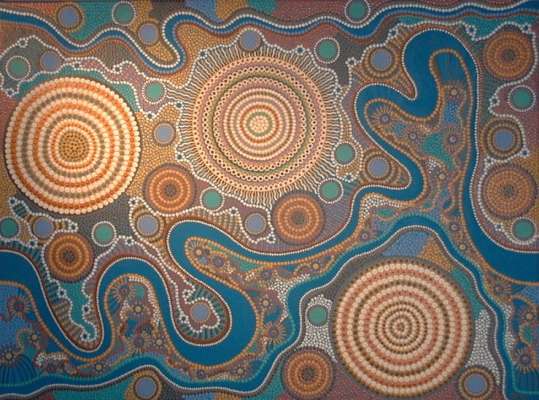Sitting back in the Art class, I took an instant interest in 'Aboriginal Art'. At the tender age of 13, this was just a new concept in my yet developing dictionary. However, it seemed to interest me. Learning about aboriginal art, started off with defining 'Aborigine'. Sounds boring and not very alarming to a 13 year old, but I took an instant likeliness to the subject. I learnt how aboriginal art is based on a foreign culture. To develop our understanding, we watched a film. Watching a film at school was always an exciting and rare occasion. However, this sometimes depends on the genre of the film we would have been watching. The film we were put in front of was called Rabbit Proof Fence.
The film gave a really moving picture of the suffering faced by people of the Aboriginal culture. The title of the film refers to to a 1,500 mile fence separating outback desert from the farmland of Western Australia. Three young girls have been taken from their mothers and and transported to a training school, with the purpose of being trained as domestic staff. this assimilation program is governed by a racist Government policy of which the purpose was to assimilate coloured people into a white society. The girls were taken as they were deemed 'half-caste' - they had one black parent and one white. The film depicts the struggle of the girls in escaping the training school and getting back to their mothers. After seven weeks and an eighteen hundred kilometer journey, they reach home. It is a moving and emotional recollection of the events which took place in the 1930's, it captures the harsh reality of the events which took place.
Moving on, the aboriginal culture is displayed well in this film and gives a further insight to the culture. The purpose of watching this film was to depict the culture portrayed in it. The art of the aborigine culture is simplistic yet tremendous.
From learning the culture of aborigines, we were to portray our own picture using the technique followed by the aborigines. The simple technique they used to display they're creativity was creating painting using small dots. In order to do this in the 21st century we used the top of our paintbrushes but in the 1930's twigs, fibres and finger tips were used. This portrayed the depth of their creativity, as they used simple everyday objects to create something which was so imaginative. The colours they used came from grinded natural extracts such as Ochre, which gave them Red, Orange, Dark Purple and Brown colour. Ochre was found naturally in rock stained by iron. Furthermore, Yellow came from mixing clay, or collecting pebbles which contained a Limonite stained form of Kaolin. Black came from charcoal, which was mixed with Kaolin to create Grey. Finally, Dark Green was made from plant colourings.
The purpose of highlighting the technique used by the aborigines, is to display the level of creativity in people in the 1930's. All the products used in those days were natural and most likely had little cost. Whereas today in order to create a painting you build up costs. You have to purchase durable paper, if not a canvas and then paint and paintbrush. Something sooo simplistic yet soo creative and unique. If we went back to using the techniques used in those days, not only would we have a project on our hands to pass the dull and wet days , we would also save!


No comments:
Post a Comment